When more tooth structure must be replaced – and gold is chosen for its long-lasting and non-abrasive characteristics – there are ESTHETIC CHOICES! Dental Gold Onlays and Crowns can be done and never seen!
By far the organization that has advanced the state-of-the-art in esthetic gold restorations over the decades was started by Richard V. Tucker, a Seattle dentist who started the Cast Gold Study Clubs locally, that eventually spread over the globe.
I would like to dedicate this Chapter and the chapter on Gold Fillings and Inlays specifically to him!
Organization of this Chapter
Basics
Gold Onlays
Retention for Gold Onlays
Marginal Adaptation for Gold Onlays
Esthetics of Gold Onlays
Full Coverage Gold Crowns
Using Axial Walls for Retention
Crown Lengthening
Partial Veneer Gold Crowns – esthetic Gold Crowns
Retention for the 3/4 Gold Crown
The Making of Gold Crowns
Bottom Line for Gold Onlays and Crowns
………………………………………………………………………………………………………………………..
Dental Gold Onlays and Crowns: Basics
Now we will discuss the options for dealing with a single tooth where the damage due to fracture, old restorations and decay is more significant than can be managed by a simple inlay or even inlay-onlay.
The topic in this chapter is GOLD restorations, whereas the next chapter will deal with PORCELAIN (or other ceramic) restorations. The chapter after that will be reserved for a significant discussion as to WHY we would rather have one than the other, and that you might have BOTH metal and porcelain for the SAME crown!
The choice of what type of indirect restoration (i.e. crown of some kind) is done, is not as obvious as you might think!
Whereas for an anterior, front tooth, the choice is pretty clear in all but the case for the rap music star, porcelain is the way to go – it must look like a natural tooth. For the posterior teeth there is more of a chance that the restoration will NOT BE SEEN – and then there can be a choice based on broader concerns.
For example, if you grind your teeth and don’t want a porcelain crown to destroy the opposing tooth, you might tend toward gold, even gold crowns that are limited in their coverage so that more natural tooth structure in the visible areas can be seen. Or you might choose a crown that has both metal and porcelain, and put the metal where it will contact the opposing tooth.
Or you might be concerned about how long the crown will last, and for that the ability of the dentist and laboratory technician to make a crown that fits the margins well is of paramount importance. For this gold would have the clear advantage. For a crown with both metal and porcelain, if metal is at the margin, that provides a longevity advantage as well.
But, NOW, we will be concerned simply with how gold restorations can be done so that they will last in the patient’s mouth for the patient’s natural lifetime, and provide an esthetic value as well.
Gold Onlays
Now we are discussing the most conservative gold restoration that will cover the entire occlusal, biting surface of the tooth. As we say, the inlay is a class II, not usually covering any cusps, and the inlay-onlay may cover a cusp or at most two, but the onlay will likely cover all of the cusps.
We need to consider how much of the tooth is left to decide how to design the onlay preparation exactly, but there will be a general similarity to most situations. Generally the tooth will need some kind of cast restoration, a crown of some sort, IF there is so much tooth structure missing that what remains is too weak to resist the forces of the mouth adequately. This situation often follows from loss of tooth structure due to previous decay and prior direct restorations, amalgams and/or composite.
IF there is an old, large amalgam restoration which covers a lot of the occlusal surface of the tooth and both sides in contact with the adjacent teeth, AND there is some other cause of tooth loss, for example more decay around the edges of the original restoration, or a fracture starting to show on a cusp – THEN an onlay may be the next most conservative thing that can be done.
To prepare the tooth for the onlay the first thing to do is remove all of the original restoration – whether amalgam or composite, it is all taken out. THEN we look for signs of decay that are progressing more into some areas and remove that. THEN we look at cusps for any signs of cracks or defects. We determine the HEIGHT VERSUS WIDTH of any remaining cusps and recognize that tall and narrow is a recipe for breakage for a tooth cusp. If the missing tooth structure leaves most or all of the cusps too tall for their girth, then they need to be protected by reducing them and covering with a layer of gold, in this case.
Retention of Gold Onlay Restorations
When a gold onlay is made, following very much the same laboratory techniques described for inlays in the last chapter, it is CEMENTED onto the prepared tooth. We would like it NOT to fall off, ever!
This means that the walls of the prepared tooth must be TALL enough, and DIVERGENT toward the occlusal (biting) surface, but not TOO divergent.
The illustrations below show a typical appearance of a tooth that is prepared for an onlay – first in a drawing for a lower molar, prepared in simulated plastic teeth for an upper molar, and as a picture of a die made for one of my patients.
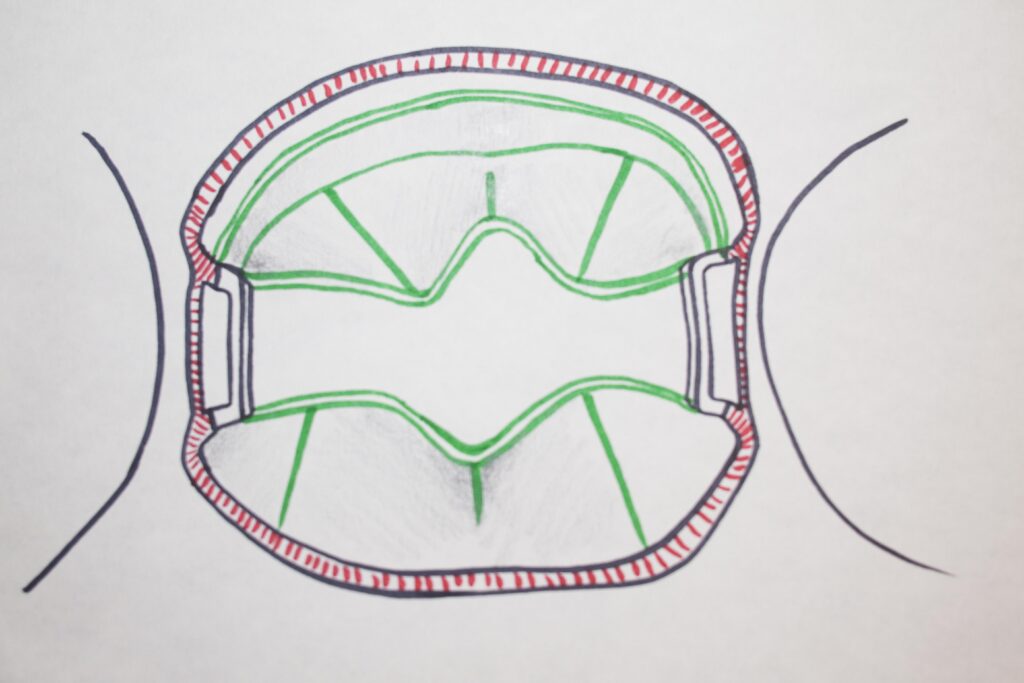
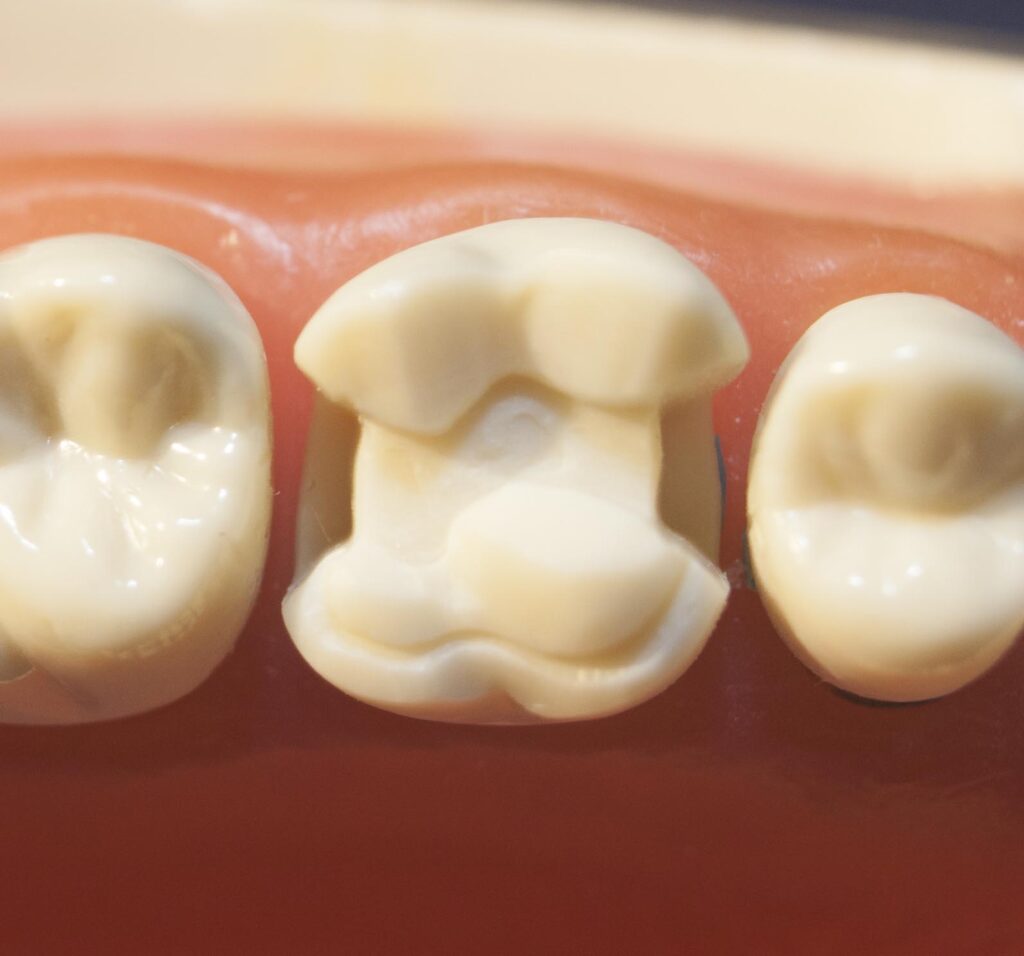
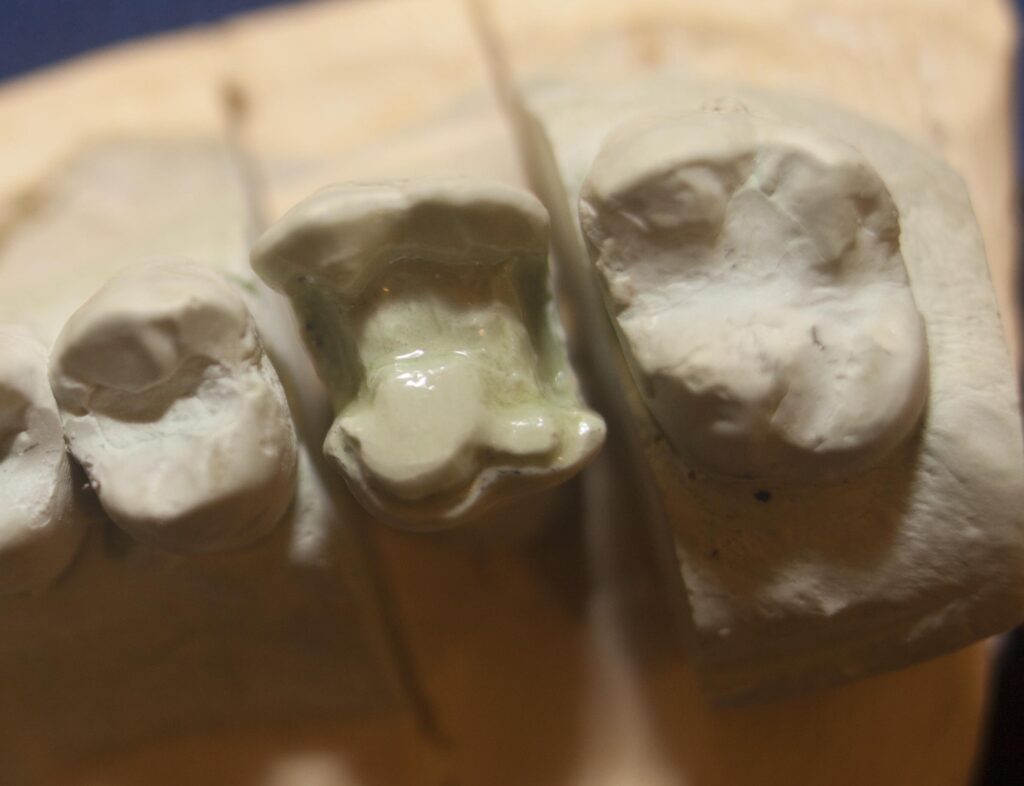
The trick is that the tooth must be cut down, or reduced on the occlusal, biting surface, so that a layer of gold 1.5 mm thick can be added to it again and have it contact the opposing tooth correctly. As the tooth is cut down, any mostly vertical walls that can be used for retention get shorter. AFTER the tooth is reduced on the occlusal, any walls of any boxes for the preparation need to be at least 3 mm tall. AND – the angle between opposing walls that are used for retention must be in the range from 6 to 12 degrees divergence. Provided these needs are met, then we can plan that when cemented well, this onlay will NOT fall off.
Marginal Adaptation for Gold Onlays
As you can see from the drawing and pictures, the place where the gold onlay meets the untouched surface of the tooth (the margin), traces out quite a path around the tooth. These margins are close to the gumline in the areas near the adjacent teeth, and much farther from the gumline on the other sides toward the cheeks and the tongue (facial and lingual walls). Moreover, in each location of the margins the design is such that the angle of gold at that margin will be small – around 45 degrees. This is what allows a good fit between the cast gold and the tooth, AND it allows for burnishing the gold so it adapts perfectly, on almost an atomic scale to the prepared tooth.
It is marginal adaptation that is responsible, more than any other factor, for the longevity of the restoration. If it stays ON the tooth, a perfect margin will not allow bacteria to congregate and start producing acid which decays the area again.
Esthetics of Gold Onlays
Since the facial and lingual surfaces of the teeth are largely and commonly left intact for onlay restorations, and the facial surfaces tend to be the most observed conversationally, the gold onlay tends to be an esthetic gold crown, where it is not observed in the mouth.
The maxillary (top) and mandibular (bottom) teeth are somewhat different in this respect, however. For the lower teeth people sometimes open their mouth and show the occlusal surfaces, and these would be seen to be gold with a gold onlay. With the mouth closed, as many people do even during smiling, and with the cheeks pulled back, even for the lower teeth there is realized an esthetic advantage for not covering the facial surface.
Even for upper premolars, which are generally easily visualized in conversation, a well made gold onlay will not show ANY gold at or over the facial cusp or on the facial surface, so your friends won’t have any idea that it is there. This is providing you are not a stage singer, or are in the habit of screaming a lot with your head tilted back!
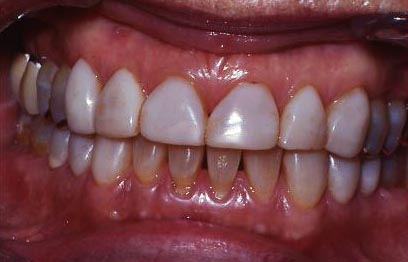
from the Front even with the Lips Pulled Back
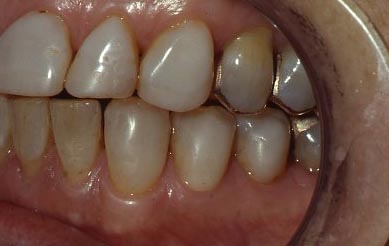
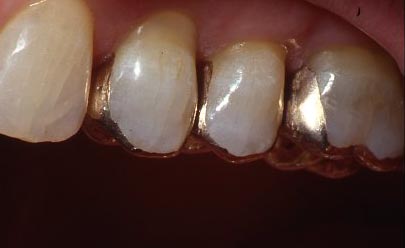
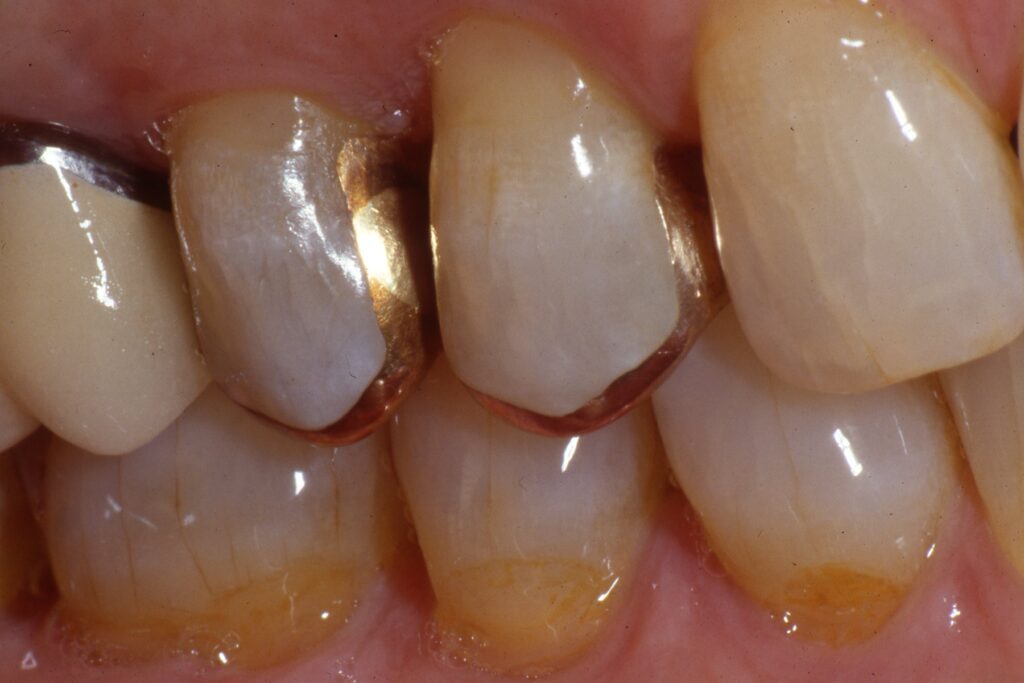
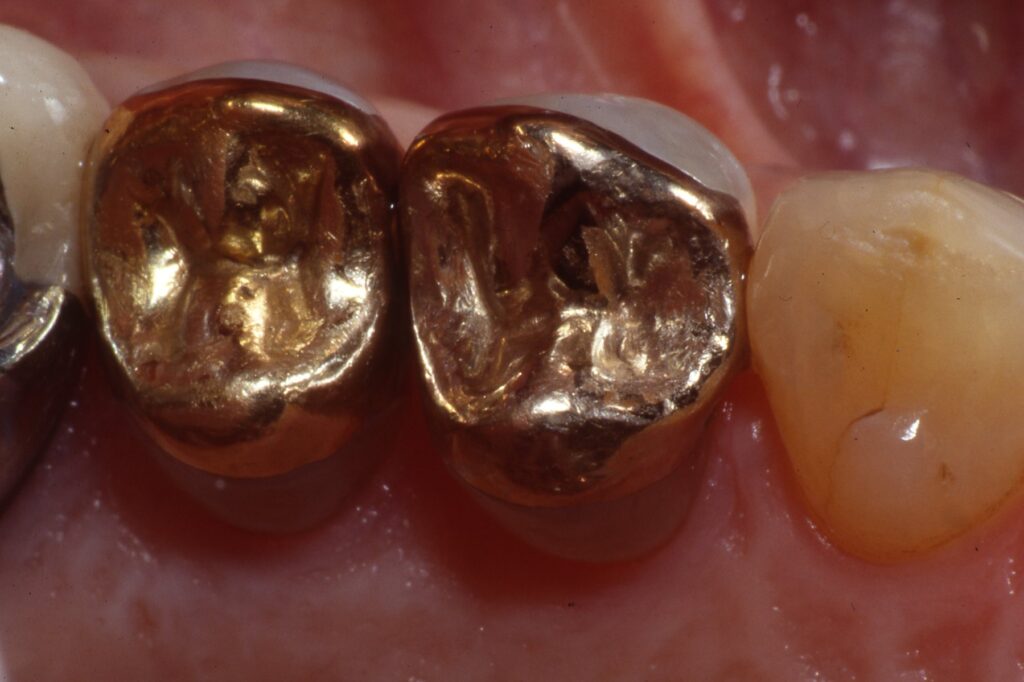
The case illustrated above was for a patient that originally had her amalgam Class II restorations replaced with composite, thinking it was healthier. The composites were done poorly, so she was in constant pain for a couple months before seeking help from me. I replaced the very large and painful composite restorations with gold onlays because the remaining cusps of all of these teeth were weak and liable to fracture.
The top two pictures shows the composite veneers that were done by the previous dentist on the anterior teeth. The shape and appearance of these veneers were unsightly and replaced later with porcelain veneers.
The Full Coverage Gold Crown – the “Cap”
Instead of using the missing internal parts of the tooth for retaining a cast gold restoration, sometimes it seems beneficial to simply bring the gold down to the gumline all around the tooth – facial and lingual walls as well as the sides toward the adjacent teeth. This is a “full” crown – it covers the outside of the tooth fully.

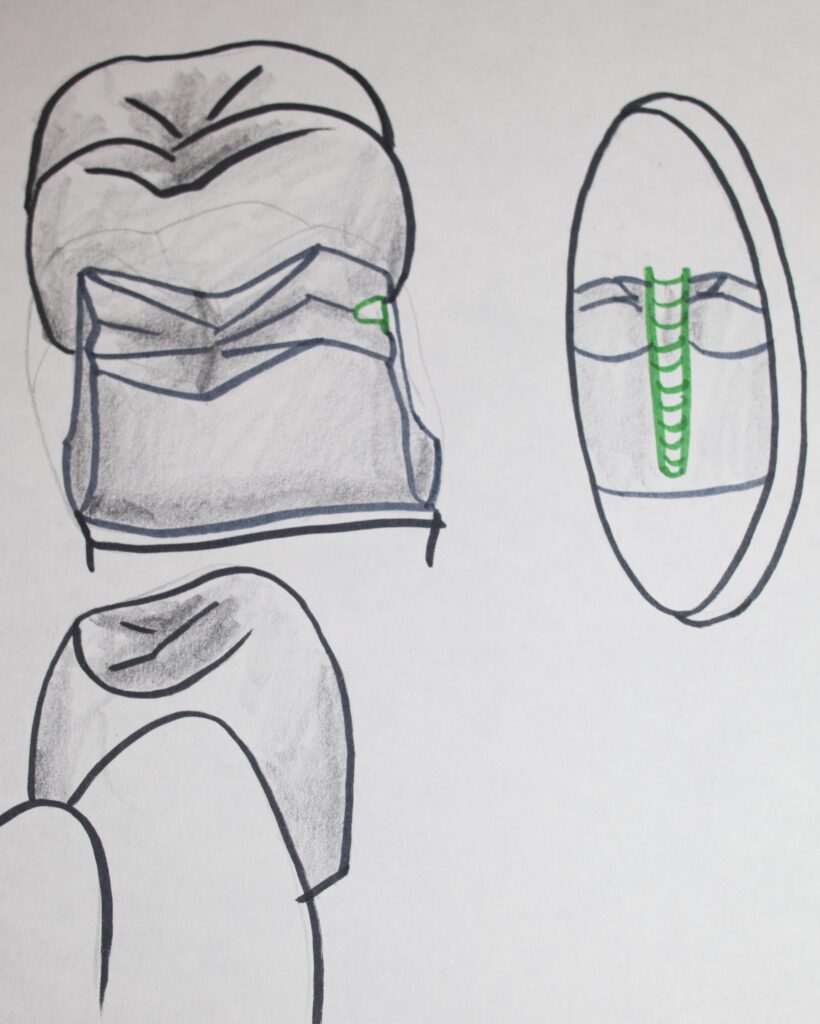
When the facial and lingual walls are not sufficiently sound, or don’t look very natural or have been restored several times, it doesn’t make sense to try to preserve these walls by doing an onlay. Also, while all dental students learn to do a gold onlay in dental school, few graduate feeling confident in that procedure, having had few patients as students that needed crowns and probably none that would benefit from the more conservative onlay. It is more for the older generations of students where onlays were more prevalent in the training because there were more patients. I had one patient, Mary, as I was a student for whom I did 6 gold onlays – and I learned from her how easy and conservative these restorations can be.
In any event – when a gold onlay is not feasible, a full gold crown can be done – using the OUTSIDE of the tooth for retention. Then, what is done with the missing parts on the inside? Good question!
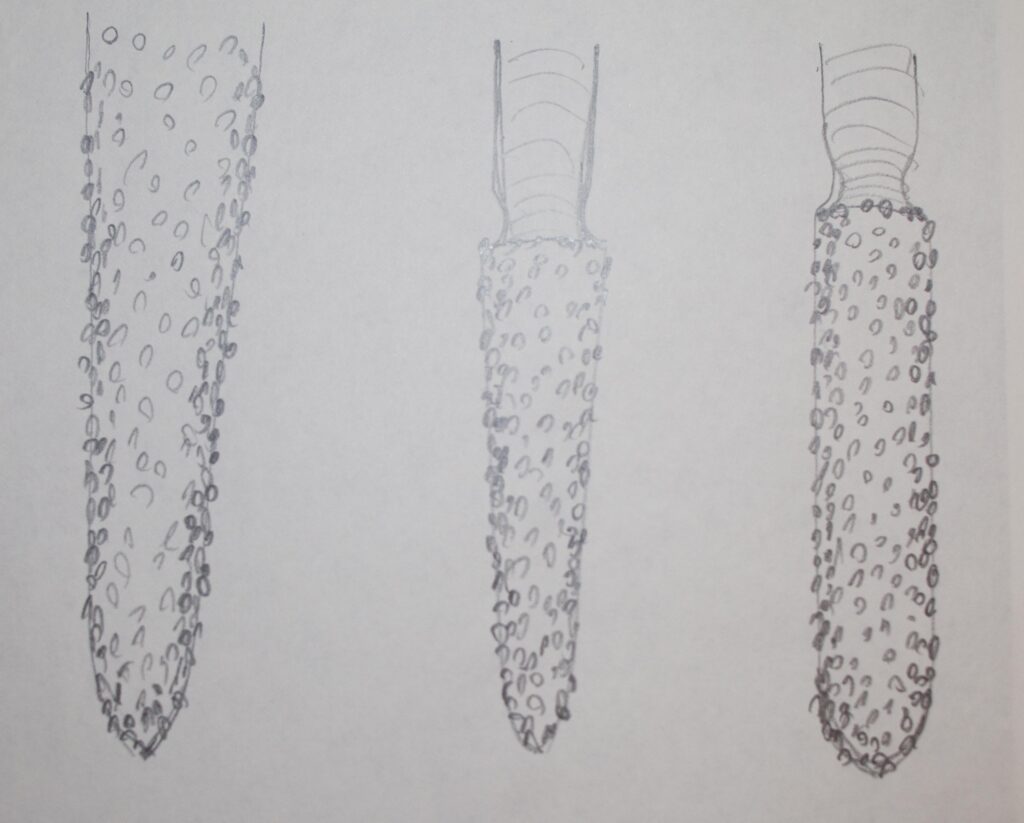
Generally the missing tooth structure inside the tooth is simply filled up with some kind of cement, more for just taking up the space than for any additional retention. On the other hand, it may be the situation that some remaining cusps are so weak that using an adhesive composite to fill in the missing areas can help to support these cusps as the crown is prepared on the outside.
It is also possible that there simply is NOT ENOUGH TOOTH left to support a crown. Maybe half the tooth is missing to near the gumline, or even all of it. In this instance a BUILDUP is done, but more on that in Chapter V.9. Also in that chapter we’ll discuss what is to be done if the tooth for the crown has had a root canal treatment done (visit Chapter V.10).
Using Axial Walls for Retention
The full-gold crown covers all FOUR of the SIDE, or AXIAL walls of the tooth with gold, as well as the protective occlusal surface. The tooth is reduced on the outside so there is enough thickness of gold to restore the tooth to its original outside contours.
After this reduction is done, the walls of the prepared tooth are flat and slightly tapered toward the center or axis of the tooth. In fact, each pair of opposing walls must be CONVERGENT toward the occlusal surface by somewhere between 6 and 12 degrees.
Actually, I gave those numbers before, but there is a range of what is achieved by practitioners. Six degrees is the textbook taper, which nobody does. Ten to twelve degrees is excellent and quite acceptable. A good prosthodontist I knew measured 10 years of his dies and found he averaged 15 degrees, whereas the average dentist these days probably tapers around 20 degrees. I would say that anything more than 20 degrees is likely to fall off at some point when it is not expected.
The axial walls have to be controlled in terms of taper and also height – a minimum of 3 mm is the “gold standard” for wall heights.
Sometimes the 3 mm wall height cannot be readily achieved. If the dentist over reduces the occlusal surface, more than the 1.5 mm desired, then the side walls get shorter, reducing retention. If the patient has ground the tooth down until it is quite short to begin with, then even a conservative occlusal reduction will give short walls. The only way to remedy this is to GO GINGIVALLY further.
To go further gingivally to get more retention may simply require moving the margin below the gingiva, into the periodontal pocket that surrounds each tooth. But this may not be enough. It is possible that we have to go below the gingiva or gumline with our margin just because there is decay that has destroyed that part of the tooth below the gingiva, but we may need to do it for retention too. If we cannot get enough wall height for retention even deep into the gingival pocket, we may have to do a surgical procedure.
Another important point is the form of the prepared tooth as it approaches the margin near the gingiva – there is a slight curvature of the wall near the margin so that the gold will be about .5 mm thick there, and angled slightly toward the gumline AT the margin. The finesse with which these walls are reduced and the margins cut determines much about how well the crown can fit, and hence the longevity of the crown as well.
Crown Lengthening
This surgical procedure involves cutting and pulling back on the gingival tissue to expose the bone underneath. Then the dentist takes a rotating bur that cuts on its side, and grinds away the bone in the area where the taller wall needs to be created, or to get below the decayed area of the tooth where the crown margin needs to be.
After the dentist recontours the bone in that area, he will suture the gingiva back together from the facial to lingual sides of the tooth, and between the teeth. The gingiva will come to rest the needed distance lower than it was before – making room to place the crown margin after all the tissue heals.
It may sound like this is an extreme procedure, but it is commonly done, and generally found by patients to have little discomfort during the healing process either immediately after the surgery, or when the sutures are removed (if not resorbable) ten days later.
Partial Veneer Crowns – the Esthetic Gold Crown
While the gold onlay is an esthetically conservative crown preparation, if the lingual surface of the tooth has enamel that is in poor condition due to decay, fracture or prior restorations, the onlay can also be made with the lingual wall covered. In this instance, however, it is no longer called an onlay – but a 3/4 crown, as three of the four axial walls are covered.
However the retention is obtained for a 3/4 crown, the name only implies the outer surfaces restored. In fact, a 3/4 crown can be done where there is little missing from the core of the tooth, or if the core of the tooth was filled in advance by some kind of cement material. There might have been boxes already there from a previous restoration, and these might under some circumstances have been filled and the crown done over them, or left open and used for retentive features just as in the onlay.
Retention for a 3/4 Crown
As mentioned, just as for the gold onlay, there may be boxes that can be used for retentive features on the sides near the adjacent teeth, but sometimes there are not preexisting boxes that can be used. So, in that case retentive features are added to the walls on each side in the form of grooves. Special burs are used to cut into the walls closest to the adjacent teeth and make tapered grooves that diverge toward the occlusal surface, as would boxes. These are small features, but will keep the crown from tipping off toward the lingual side when forces are exerted in that direction.
The picture, below, shows a 3/4 crown preparation in a plastic tooth – and you can see the grooves on both sides.
While the unreduced wall is generally the facial one for a 3/4 crown, because of the obvious esthetic value, there are times where we plan to do a full crown, but one wall is too short for retention. This may be due to the height and nature of the gingiva on one side of the tooth, often the side toward the back of the mouth, particularly if it is the last tooth in the arch. In this case we cannot get a significant wall height on that side for a full crown preparation, and for all intents and purposes it is a 3/4 crown, just rotated 90 degrees. In order to keep the crown from tipping off toward the FRONT of the mouth, grooves are added on the facial and lingual surfaces of the preparation.
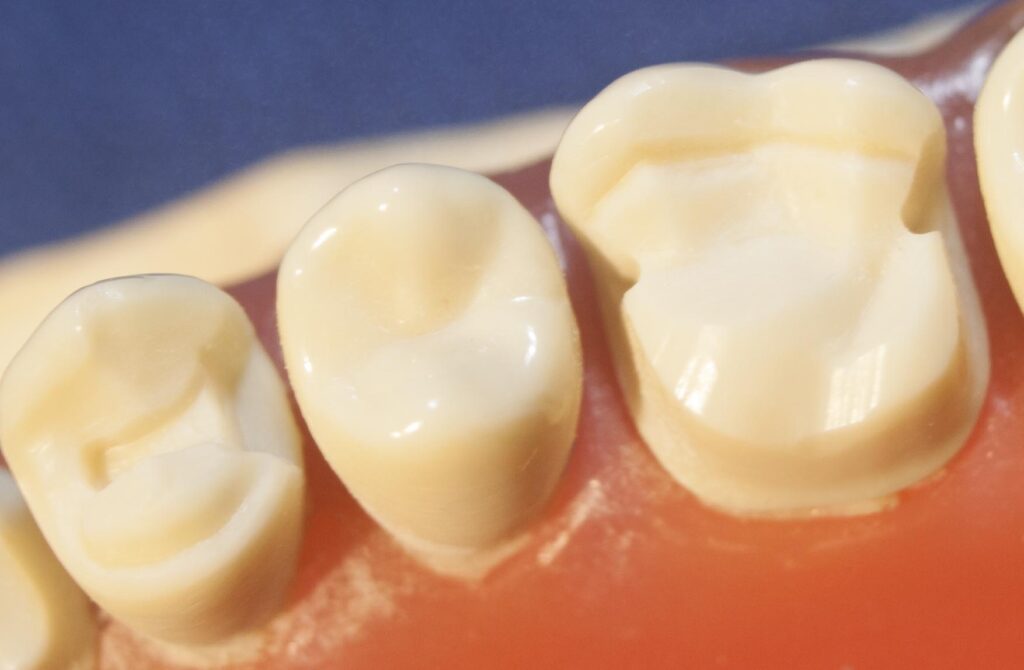
The Making of a Gold Crown
As we saw in the chapter on Inlays (visit Chapter V.5), fabrication of a gold restoration has many steps. These include the impression, pouring the models, sectioning and trimming the die, making the wax pattern, investing the wax pattern, casting the gold into the investment, and breaking out the casting, trimming and polishing it.
One thing I didn’t comment on before is the research work that had to go into making this all work. Just consider for a moment that we have prepared a tooth in a patient’s mouth, and after all these steps we come back with a gold crown that actually FITS. When you consider that every one of these steps involves some expansion and contraction, it seems impossible. BUT – someone figured out how to get all of the expansions and contractions of the different materials to exactly compensate, so the final result is exactly correct!
The only difference between making a crown which covers all of the occlusal, biting, surface of the tooth and an inlay, which covers only a small part, is that for the crown we need to be much more careful about how it fits the OPPOSING TOOTH! The bite needs to be good. When we deliver it to the patient and cement it onto their prepared tooth, they should bite down and not feel it. It should be in exactly the same occlusion as the original tooth that was cut down.
The ways this is done, or at least the way it is done so that very little adjustment needs to be done in the patient’s mouth, is to mount the cast so it is hinged against a cast of the opposing teeth, exactly the way they meet in the mouth – AND to make sure that the two casts slide around on each other with a flexible hinge so that the movements mimic the movement in the patient’s mouth. The accuracy with which this needs to be done varies – but in large restorations where many crowns are made at the same time, the opposing models must be mounted accurately so that the position of the actual condyle of the TMJ is duplicated, as is the shape of the slope of the TMJ. Most dentists don’t work at this level of precision, but a prosthodontist often will.
In any event, whether it is a full gold crown or a 3/4 crown, (or can you picture a 7/8 crown?), great care must be taken at every step of the fabrication process to ensure accuracy of fit. When the crown is delivered to the patient it is tried in and adjusted for contact with the adjacent teeth and opposing tooth, and cemented with an agent made for the purpose.
Bottom Line for Dental Gold Onlays and Crowns
For the posterior teeth, where they tend to be less seen conversationally, the use of gold crowns has some distinct advantages.
First – the gold in occlusion with the opposing teeth does not grind them away.
Second – the margins of gold crowns are very well adapted, especially when burnished for onlays and 3/4 crowns, and this leads to a longer lasting crown.
Third – for gold the reduction of the tooth is much less than for porcelain or ceramic crowns, so there is less irritation to the tooth during the process.
Fourth – gold does NOT need to cover all of the surfaces of the tooth, so there are times where a partial gold crown cannot be seen by the patient’s friends. This simply requires that the remaining tooth structure that IS visible, is in good condition and matches the other teeth in the arch.
Gold restorations are considered by many dentists to be “old fashioned”, or you might hear them say, “nobody does those anymore”! Sometimes these statements are made to convince the patient that they should be getting porcelain or ceramic restorations – but often this is profit-driven, sad to say.
The use of gold or other noble metals and porcelain or a combination of the two represents the great versatility of the dentistry that CAN be done to restore teeth that have a lot of damage. We will learn more about this in the next two Chapters.